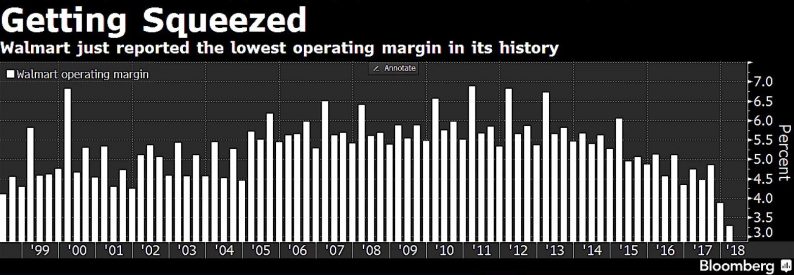Wal-Mart Margins Shrink
Wal-Mart stock fell 2.75% on Wednesday as the stock is in complete free fall. It’s down 16.46% since January 29th. I don’t think the selloff in Wal-Mart signifies overall weakness from the consumer because the same store sales growth was fine. There are 3 main causes of the decline in WMT. The first is that it ran up way too much prior to the quarter. From January 27th, 2017 to January 26th, 2018, the stock acted like a momentum tech name as it was up 65.08%. For a company which grows revenues in the low single digits, that makes no sense. The other reason, which I mentioned previously, was the sharp deceleration in online sales growth.
The third reason can be seen in the chart below. With the increases in the minimum wage and the competition from Amazon, the firm just reported its lowest operating margin in its history. This information matches perfectly with the stock having its worst day since January 1988. This is all good news for the consumer since it means they get better wages and lower prices because of competition and the advancement in online retail.

Moderately Bearish Sentiment
The sentiment had been euphoric for over a year, but it has changed recently. I think this is great news because the faster the sentiment changes, the more likely the market will make a new high. The poll below supports the point that being bearish is popular. As you can see, 57% of respondents think the market will make a lower low than 2,533 on the S&P 500. This market appears to be technically driven. There isn’t much of a fundamental reason why stocks should go lower. I wouldn’t rule it out obviously. The potential for a re-test of the lows dominated trader’s conversations. If the low holds, it’s a bullish sign and if it doesn’t, the market could fall to 2,400.

Stock & Bond Correlation
As I mentioned in a previous article, the S&P 500’s correlation with the 10 year bond yield is tough to gauge because sometimes it’s correlated and sometimes it isn’t. The near term action is similar to the long term action. As you can see from the chart below, the rolling 5 year correlation has moved back and forth. It’s crazy to say the 10 year yield is causing stocks to fall since it doesn’t come close to always moving in the opposite direction of the stock market. That being said, I’m bullish on stocks and bullish on treasuries. In that situation, yields and stocks would be inversely correlated.













Leave A Comment